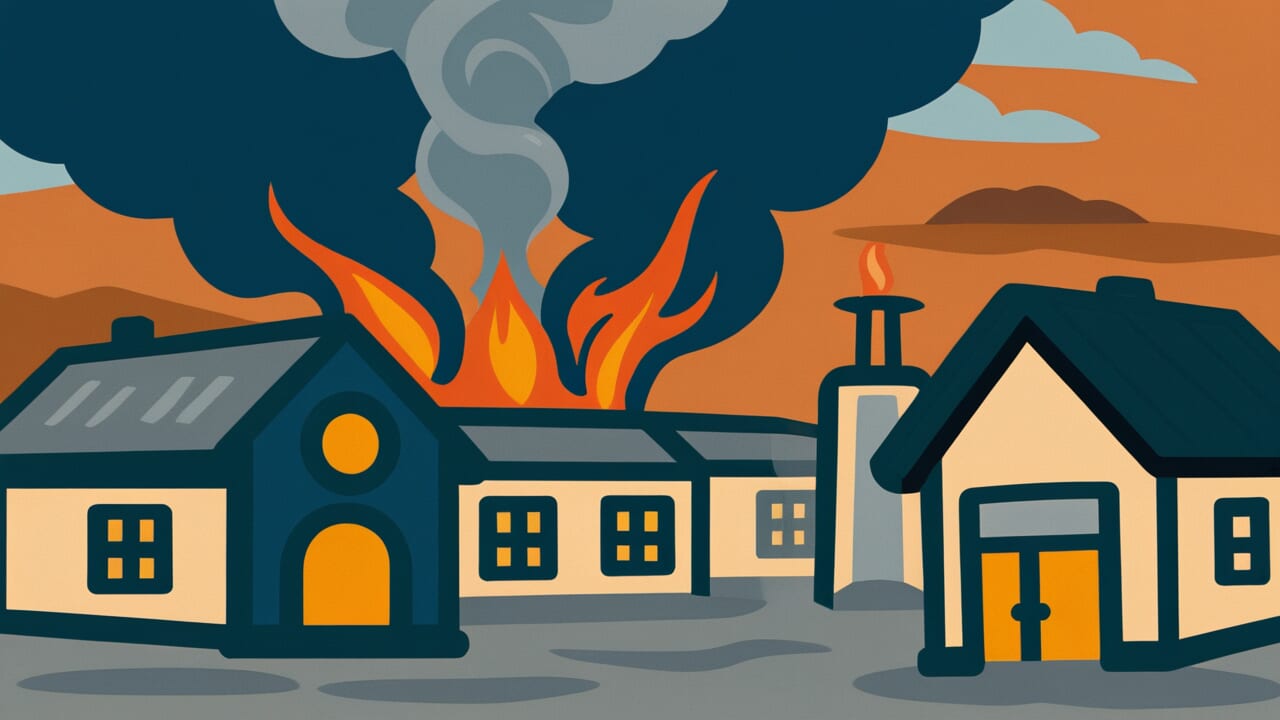How to Read “Where there is smoke there is fire”
Where there is smoke there is fire
[WAIR thair iz SMOHK thair iz FY-er]
All words use common pronunciation.
Meaning of “Where there is smoke there is fire”
Simply put, this proverb means that rumors or warning signs usually point to real problems underneath.
The literal words paint a clear picture. When you see smoke rising, fire is almost always the cause. You might not see the flames yet, but something is definitely burning. The proverb uses this natural fact to teach us about human situations.
In daily life, we use this saying when gossip starts spreading or warning signs appear. If people whisper about trouble at work, there might be real problems brewing. If your friend seems upset but won’t talk, something is probably bothering them. The “smoke” represents the hints and clues we notice.
What makes this wisdom powerful is how it balances caution with common sense. It doesn’t say every rumor is completely true. Instead, it suggests that repeated signs usually mean something real is happening. People have learned that ignoring too many warning signals often leads to bigger problems later.
Origin and Etymology
The exact origin of this proverb is unknown, but similar sayings have existed for centuries across many languages. The concept appears in various forms throughout European literature and folk wisdom. Early versions focused on the practical relationship between smoke and fire that everyone could observe.
During medieval times, when most people lived in small communities, this type of saying served an important purpose. Information traveled slowly, and people relied heavily on observation and local knowledge. Spotting smoke could mean the difference between saving a building or losing it entirely. This practical wisdom naturally extended to social situations.
The proverb spread through oral tradition and eventually appeared in written collections of folk sayings. As printing became more common, these practical observations were recorded and shared more widely. The saying evolved from a literal warning about fire safety into a broader lesson about reading signs and taking rumors seriously.
Interesting Facts
The word “smoke” comes from Old English “smoca,” which originally described any kind of vapor or mist. Ancient peoples understood the connection between smoke and fire long before they understood the science behind combustion. This proverb uses one of humanity’s oldest and most reliable cause-and-effect relationships to teach a lesson about hidden truths.
Usage Examples
- Manager to HR director: “Three employees have complained about their supervisor this week – where there is smoke there is fire.”
- Neighbor to neighbor: “I keep seeing police cars on their street lately – where there is smoke there is fire.”
Universal Wisdom
This proverb taps into a fundamental human survival mechanism that kept our ancestors alive for thousands of years. The ability to read warning signs and connect scattered clues to hidden dangers was essential for survival. Those who ignored the “smoke” often faced serious consequences when the “fire” finally revealed itself.
The wisdom reflects our deep understanding that most significant events cast shadows before they happen. Problems rarely appear without warning signs. Conflicts build gradually through small tensions. Opportunities often announce themselves through subtle hints. Our brains evolved to notice patterns and make connections, even when we can’t see the complete picture yet.
What makes this particularly human is our complex relationship with information and truth. Unlike other animals who respond directly to immediate threats, humans live in layers of social reality filled with rumors, gossip, and incomplete information. We must constantly decide which signals deserve attention and which can be safely ignored. This proverb acknowledges that while not every rumor proves true, dismissing all warning signs is dangerous. It captures the delicate balance between healthy skepticism and necessary caution that has helped human communities navigate uncertainty for generations.
When AI Hears This
Humans don’t just spot hidden problems from warning signs. They actually create elaborate stories from tiny clues. A single rumor becomes proof of conspiracy. One complaint transforms into evidence of widespread failure. People take scattered dots and connect them into complete pictures that feel absolutely real.
This mental process happens automatically across all cultures and time periods. The human brain cannot tolerate uncertainty or incomplete information. It fills gaps with assumptions that seem logical. People would rather believe a complete wrong story than accept partial truth. This explains why gossip spreads faster than facts and why first impressions stick so powerfully.
What fascinates me is how this “flaw” actually works brilliantly most of the time. Humans who jump to conclusions often survive better than those who wait. Quick pattern-matching catches real dangers before they fully emerge. The same mental trick that creates false rumors also prevents genuine disasters. It’s beautifully imperfect – wrong enough to cause problems, right enough to save lives.
Lessons for Today
Living with this wisdom means developing better instincts for reading situations and people. When multiple small signs point in the same direction, paying attention often prevents bigger problems later. This doesn’t mean believing every piece of gossip, but rather learning to distinguish between random noise and meaningful patterns.
In relationships, this wisdom helps us notice when something feels off before major conflicts explode. If a friend seems distant, a coworker appears stressed, or family dynamics feel tense, these might be early signals worth exploring gently. The key is responding to the “smoke” with curiosity rather than panic, asking questions and offering support before situations become critical.
The challenge lies in balancing this awareness with fairness and kindness. Not every sign points to disaster, and jumping to conclusions can damage relationships and create unnecessary drama. The wisdom works best when combined with patience and good judgment. Instead of assuming the worst when we notice warning signs, we can use them as invitations to pay closer attention, ask better questions, and offer help when appropriate. This approach honors both the practical wisdom of our ancestors and the complexity of modern life.



Comments